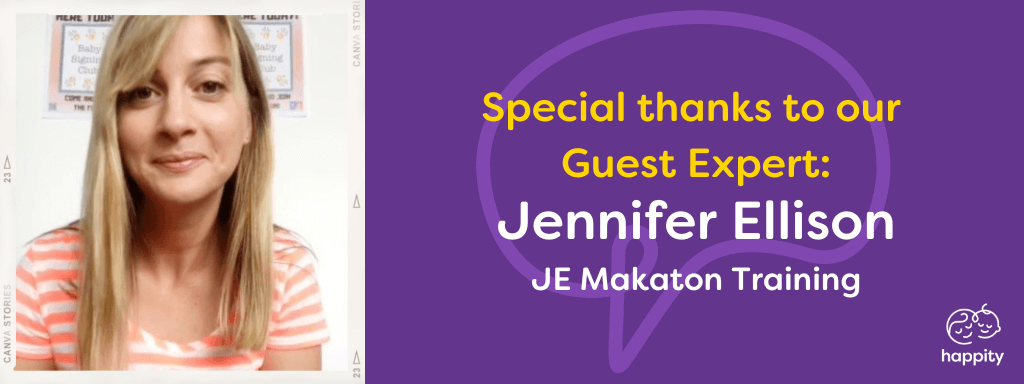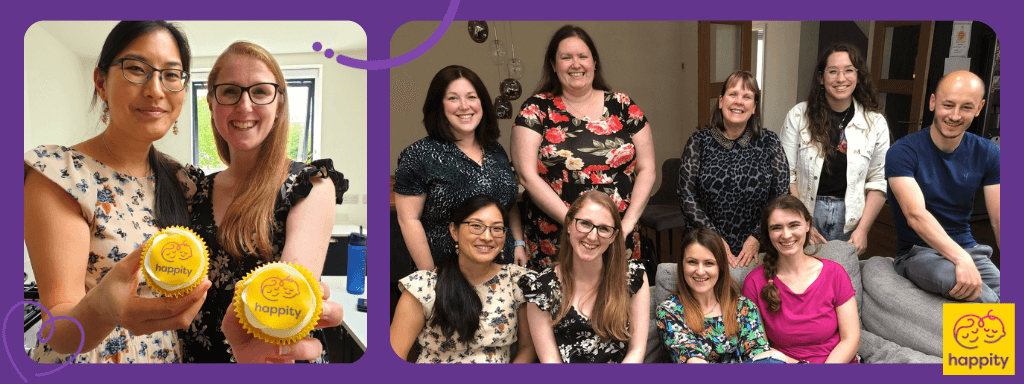What is Makaton and why is it something you should start using in your baby and toddler classes?
Recently, we were lucky to be joined by guest expert, Jen Ellison from JE Makaton training, who gave us a great introduction to Makaton, helping to answer our questions and get to understand the language programme more.
We hope that the following can help you to decide whether or not using Makaton in your classes is for you. As well as where to go if you want to start learning more today. Read on!
What Is Makaton Used For?
Makaton is a form of communication that uses symbols, signs and speech to support the development of early essential communication skills. Including; attention and listening; eye contact; imitation; turn-taking; comprehension; memory; and vocalisation.
As a speech and language therapist, Jen has encouraged the use of Makaton to build bridges in families, helping parents to communicate with their children who struggle to communicate (for lots of different reasons!). It has been used in lots of SEND environments, including for children who are diagnosed with autism, down syndrome, cerebral palsy, developmental language disorder and more.
Not only is it a great idea alone to use Makaton to make your baby classes inclusive, but it also helps to make language inclusive for everyone, including the tiny attendees in your classes who are in the crucial early stages of learning to talk.
How Is Makaton Different To Sign Language?
Makaton is a language programme, not a Sign Language. But what does that actually mean? There are a few main differences between Makaton and British Sign language.
For starters, British Sign Language is often used in the UK to communicate with those who are deaf. When signing, you don’t speak and you often use a different word order to spoken English. So for example, ‘The penguin is on the bridge’ in British sign language would be signed as ‘bridge penguin on’ (you would place the sign for penguin on the bridge as there is a big focus on sign placement.). Sign language also has variations depending on regional dialect (similar to spoken English, just like our different accents)
Makaton, however, has a few differences. It’s a speech and language programme, meaning that speech is always used as you sign. It has been intentionally put together by speech and language therapist (Margaret Walker) to support communication for spoken language. It is carried out by matching signs to the keywords of your sentence, but you don’t necessarily sign every word you say. For example ‘The penguin is on the bridge’ in Makaton would be signed as ‘Penguin on bridge’. Makaton, unlike sign language, remains the same across the entire country.
However, the one thing that remains the same across the two is the signs that are used. When forming Makaton, Margaret Walker decided to choose the signs that most resembles the word and is the easiest to sign.

Does It Help To Use Makaton In Your Baby Classes?
Like we mentioned before, making language visible is useful for not just those with SEND, but for everyone. The babies and toddlers who come to your classes are still in the very early years of learning language.
Makaton comes in handy for all families wanting to communicate with their little ones, and with practice becomes second nature in an early-years environment. We can all be Makaton users and show our families how easy it can be to make our language visual by adding in some signs and symbols to our everyday talking. We can surround our little ones with this additional visual language so that they can subtly pick it up which is beneficial for everyone. So learning this language and using it in your classes may help families in more ways than one!
Jen, our guest expert from the original Makaton Webinar, had these top tips for using Makaton in your classes:
- Always introduce yourself using Makaton
- Don’t say anything different to how you would normally say it. Speak how you would normally speak!
- Only sign the keywords in your sentence
- Always speak and sign
- Share that you are inclusive and using Makaton in your class listing and with your attendees. Allow families to know that by coming to your classes they can feel included.
How Easy Is It To Learn Makaton?
One of the best free tutors out there (if you’re just feeling a little curious about Makaton) is actually Mr. Tumble!
While there may be a few signs that you see online, tutors can’t recommend all of them as they simply can’t moderate across the whole of social media. But, Mr Tumble has been approved to learn Makaton signs and symbols.
Or, if you’re looking to attend a workshop and get guidance from an expert, then we can wholly recommend our guest speaker for our original webinar: Jen Ellison from JE Makaton Training. She offers both taster sessions as well as different levels of training.
You can book a workshop with Jen here
Interested In Attending A Future Happity Webinar?
If you are a Happity Member, then good news! Our monthly webinars are included with your Membership and you can attend for free.
If you are not a member however, then webinars cost just £5 to attend: an affordable way to learn new business skills for your baby classes.
Find out more about what we have up and coming in the future on our webinars page
Happity: Created with baby class providers in mind!
If you are looking for ease and a listing/booking service that’s catered specifically to you (busy parents and small business owners) then you’ve found the right blog page.
It’s free to list with Happity, and you can offer all sorts of ticket options through our site. Though we also offer cost-effective membership for when your baby class needs an extra boost in its marketing or if you would like access to our provider-catered booking system.
Get your classes seen by thousands of parents today
If you liked this post, you may also like:
4 Ways To Get Your Baby Classes Featured In Happity’s Marketing
Running an Outdoor Baby Class: 9 Things You Need To Consider
How To Choose A Booking System For Your Baby And Toddler Classes







